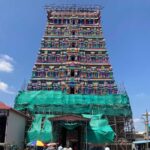Table of Contents
Uthirakosamangai shiva temple
Who build Uthirakosamangai temple?
History of Uthirakosamangai or Mangalanathar swami Temple is believed to have been built by a Pandya king around 3000 years ago and was later renovated between 1529 and 1542 CE by the Nayak and Sethupathi dynasties.
Uthirakosamangai Temple has a fascinating history, with connections to both the Ramayana and Rameshwaram, and is believed to have existed even before the time of the Ramayana.
More importantly, in the Ramayana, Ravana was married to this temple.
This is evidenced by the fact that the names of the Mandori . her name is mentioned in temple inscriptions.
Mandodari performed a severe penance to Lord Shiva, saying that she would marry only the greatest devotee of Lord Shiva in the world.
In response to her devotion and request, Lord Shiva personally appeared and married Mandori to Ravana.
Why this temple called Uthirakosamangai?
The reason why this temple got its name Uttarakosamangai is because it is said that Lord Shiva recited the Pranava mantra Om to Goddess Parvati at this very place where this temple is located.
This uthirakosamangai temple is the first temple built for Lord Shiva in the world and is also the birthplace of Lord Shiva.
How old is this Shiva temple?
There is a lindsay (ilanthai) tree in this temple. Historical accounts and legends say that it was under this lindsay tree that Lord Shiva was created as a Swayam Linga.
More importantly, archaeologists have proven that this ilanthai tree is 3000 years old.
Only recently built temples have Navagraha worship established. There is no such thing as Navagraha worship in any temple built in ancient times. Therefore, in this temple, only the three planets, the Moon, Sun, and Mars, are worshipped. So, they say that this temple is still a very old temple.
The Emerald Nataraja Statue
The cosmic dance form of the Lord is created in this temple from emerald stone.
This is the most priceless thing in this world, the Emerald Nataraja statue created in this temple. They cut a large emerald rock, made a Five-foot statue out of it, and placed it on a one-and-a-half-foot pedestal, carefully carved to the point where all the veins in the hand are visible.

If you ask if you can see this emerald Nataraja statue every day, you can’t. One day a year, on the day of Thiruvadhirai, the sandalwood paste is removed and only then can the Emerald Nataraja statue be seen. On other days, he remains covered in sandalwood paste.
They will not take out this emerald Nataraja statue. Therefore, when performing abhishekam, they use the idol of Panchaloka Nataraja there.This Panchaloka Nataraja statue is also very ancient.
More Interesting Facts about Uthirakosamangai temple:
There is a Yazhi carved out of stone in this temple. There is a ball-like stone in the mouth of that yazhi. We can do whatever we want with those ball, but we can’t take that out.
Generally, all Shiva temples are worshipped with the sound of drums. But in this Shiva temple, pujas are performed without any drums. This is because even some of the vibrations that die down in the upper drums should not affect the Emerald Nataraja statue.
Not only this, but in no other Shiva temple is a Thalam flower used for worship. But in this temple, they worship Lord Shiva only with Thalam flower.
Uthirakosamangai temple distance :
The Hindu temple is located in Tamil Nādu 70 km from Rameswaram and 13 km from Ramanathapuram and this temple covers an area of approximately 20 acres.
uthirakosamangai temple timings :
Morning: 6:00 AM to 12:00 PM
Evening: 4:00 PM to 8:00 PM
These timings may vary slightly on special occasions, festivals, or public holidays, so it’s always a good idea to confirm locally if you’re planning a visit during a specific time. Let me know if you need more details about the temple!
Festivals:
Masi Magam Festival (February/March):
This is the most important festival at the Uthirakosamangai Temple. It is celebrated during the Tamil month of Masi (February-March) when the full moon day coincides with the Magam star.
The festival draws a large number of devotees, who come to take a holy dip in the nearby Agni Theertham (sacred water tank) and offer prayers to Lord Shiva and Goddess Parvati.
Special rituals, processions, and prayers are held during this time, and the temple is beautifully decorated. The temple chariot is also paraded during the festival.
Shivaratri (February/March):
The auspicious night of Maha Shivaratri is celebrated with special prayers, chanting, and night-long vigils in honor of Lord Shiva. Devotees gather at the temple to perform Abhishekam (ritualistic bathing of the deity), offer Bilva leaves, and participate in spiritual discourses and prayers.


